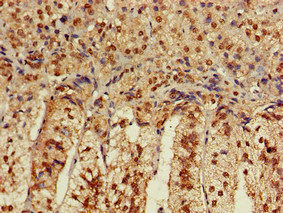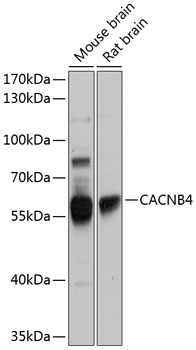
WB analysis of human bone marrow lysate using GTX89203 Cav beta 4 antibody, Internal. Dilution : 0.2microg/ml Loading : 35microg protein in RIPA buffer
Cav beta 4 antibody, Internal
GTX89203
ApplicationsWestern Blot
Product group Antibodies
TargetCACNB4
Overview
- SupplierGeneTex
- Product NameCav beta 4 antibody, Internal
- Delivery Days Customer7
- Application Supplier NoteWB: 0.2-0.6microg/ml. *Optimal dilutions/concentrations should be determined by the researcher.Not tested in other applications.
- ApplicationsWestern Blot
- CertificationResearch Use Only
- ClonalityPolyclonal
- Concentration0.50 mg/ml
- ConjugateUnconjugated
- Gene ID785
- Target nameCACNB4
- Target descriptioncalcium voltage-gated channel auxiliary subunit beta 4
- Target synonymsCAB4, CACNLB4, EA5, EIG9, EJM, EJM4, EJM6, voltage-dependent L-type calcium channel subunit beta-4, calcium channel voltage-dependent subunit beta 4, dihydropyridine-sensitive L-type, calcium channel beta-4 subunit
- HostGoat
- IsotypeIgG
- Protein IDO00305
- Protein NameVoltage-dependent L-type calcium channel subunit beta-4
- Scientific DescriptionThis gene encodes a member of the beta subunit family of voltage-dependent calcium channel complex proteins. Calcium channels mediate the influx of calcium ions into the cell upon membrane polarization and consist of a complex of alpha-1, alpha-2/delta, beta, and gamma subunits in a 1:1:1:1 ratio. Various versions of each of these subunits exist, either expressed from similar genes or the result of alternative splicing. The protein encoded by this locus plays an important role in calcium channel function by modulating G protein inhibition, increasing peak calcium current, controlling the alpha-1 subunit membrane targeting and shifting the voltage dependence of activation and inactivation. Certain mutations in this gene have been associated with idiopathic generalized epilepsy (IGE), juvenile myoclonic epilepsy (JME), and episodic ataxia, type 5. [provided by RefSeq, Aug 2016]
- Storage Instruction-20°C or -80°C,2°C to 8°C
- UNSPSC12352203





